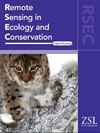协变量影响最佳相机-陷阱调查设计的占用模型
IF 4.3
2区 环境科学与生态学
Q1 ECOLOGY
引用次数: 0
摘要
运动激活相机(“相机陷阱”)已经成为野生动物监测不可或缺的工具。摄像机-陷阱调查的数据可用于推断动物行为、空间利用和种群动态。占用模型是一种通常用于分析相机-陷阱数据的统计框架,它在考虑不完全检测的同时估计物种的发生。在模型中包括协变量可以调查占用率和环境之间的关系。调查设计研究帮助从业者决定要部署的摄像机数量、部署时间和摄像机定位。然而,现有的评估通常假设恒定的占用率和可探测性(即不考虑协变量),这对于大多数现实世界的场景来说是不现实的。我们研究了协变量对调查工作量与占用模型的准确度和精度(即误差)组合之间关系的影响。“虚拟”物种的相机-陷阱数据被模拟为随机生成的特定于地点和调查的协变量(例如,栖息地类型/质量和温度)的函数。然后,我们评估了不同的调查设计和总努力是如何影响有和没有协变量信息的估计误差的。增加摄像机数量可以持续减少误差,而长时间的部署只有在协变量影响占用时才有益。当两个参数都受到协变量的影响时,忽略对可检测性的影响对模型性能的影响有限。然而,如果不考虑对占用率的影响,则会显著增加误差,并且即使使用9000摄像机天的最大调查工作,也无法实现预定义的阈值(均方根误差= 0.15,0.10和0.075)。这些结果表明,增加调查工作不太可能提高模型的性能,除非适当地模拟了现场水平的条件。因此,稳健的研究设计应考虑总体努力和跨站点的协变量监测,以确保时间和财力资源的有效利用。本文章由计算机程序翻译,如有差异,请以英文原文为准。
Covariates influence optimal camera‐trap survey design for occupancy modelling
Motion‐activated cameras (‘camera‐traps’) have become indispensable for wildlife monitoring. Data from camera‐trap surveys can be used to make inferences about animal behaviour, space use and population dynamics. Occupancy modelling is a statistical framework commonly used to analyse camera‐trap data, which estimates species occurrence while accounting for imperfect detection. Including covariates in models enables the investigation of relationships between occupancy and the environment. Survey design studies help practitioners decide the number of cameras to deploy, deployment duration and camera positioning. However, existing assessments have generally assumed constant occupancy and detectability (i.e. no covariates were considered), which is unrealistic for most real‐world scenarios. We investigated the effects of covariates on the relationship between survey effort and the combination of accuracy and precision (i.e. error) of occupancy models. Camera‐trap data for a ‘virtual’ species were simulated as a function of randomly generated, site‐ and survey‐specific covariates (e.g. habitat type/quality and temperature, respectively). We then assessed how varying survey design and total effort influenced estimation error with and without covariate information. Increasing the number of cameras consistently reduced error, while longer deployments were only beneficial when the covariate influenced occupancy. When both parameters were affected by covariates, omitting effects on detectability had limited impact on model performance. However, failing to account for effects on occupancy significantly increased error, and none of the predefined thresholds (root mean squared error = 0.15, 0.10 and 0.075) were achievable, even with the maximum survey effort of 9000 camera‐days. These results suggest that increasing survey effort is unlikely to improve model performance unless site‐level conditions are appropriately modelled. Thus, robust study design should consider total effort and the monitoring of covariates across sites to ensure efficient use of time and financial resources.
求助全文
通过发布文献求助,成功后即可免费获取论文全文。
去求助
来源期刊

Remote Sensing in Ecology and Conservation
Earth and Planetary Sciences-Computers in Earth Sciences
CiteScore
9.80
自引率
5.50%
发文量
69
审稿时长
18 weeks
期刊介绍:
emote Sensing in Ecology and Conservation provides a forum for rapid, peer-reviewed publication of novel, multidisciplinary research at the interface between remote sensing science and ecology and conservation. The journal prioritizes findings that advance the scientific basis of ecology and conservation, promoting the development of remote-sensing based methods relevant to the management of land use and biological systems at all levels, from populations and species to ecosystems and biomes. The journal defines remote sensing in its broadest sense, including data acquisition by hand-held and fixed ground-based sensors, such as camera traps and acoustic recorders, and sensors on airplanes and satellites. The intended journal’s audience includes ecologists, conservation scientists, policy makers, managers of terrestrial and aquatic systems, remote sensing scientists, and students.
Remote Sensing in Ecology and Conservation is a fully open access journal from Wiley and the Zoological Society of London. Remote sensing has enormous potential as to provide information on the state of, and pressures on, biological diversity and ecosystem services, at multiple spatial and temporal scales. This new publication provides a forum for multidisciplinary research in remote sensing science, ecological research and conservation science.
 求助内容:
求助内容: 应助结果提醒方式:
应助结果提醒方式:


